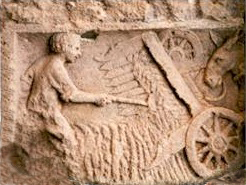Agriculture in ancient Rome
Agriculture in Ancient Rome played a crucial role in the economy and society of the Roman Empire. From the founding of the city of Rome in the 8th century BC until the fall of the Western Roman Empire in the 5th century AD, agriculture supported the vast empire, feeding its citizens, armies, and providing the basis for its wealth and power.
History[edit | edit source]
The history of Roman agriculture traces back to the city's origins, where the early Romans were primarily farmers. The fertile lands of the Italian peninsula, along with the adoption of advanced agricultural techniques from neighboring civilizations, allowed Roman agriculture to flourish. Over time, as Rome expanded, it incorporated new territories that were rich in agricultural resources, further boosting the empire's agricultural output.
Crops and Livestock[edit | edit source]
The main crops grown in ancient Rome included grains such as wheat, barley, and millet, which were staples of the Roman diet. Romans also cultivated olives for oil, grapes for wine, and various fruits and vegetables. Livestock, including cattle, pigs, sheep, and goats, were raised for meat, dairy products, and wool. The Romans also practiced viticulture and olive cultivation, which were integral to their diet and economy.
Agricultural Practices[edit | edit source]
Roman farmers employed a variety of agricultural practices to maximize their yields. They used tools like the plough and techniques such as crop rotation and irrigation to improve soil fertility and manage water resources. The Romans also utilized manure as fertilizer and employed slave labor on larger estates, known as latifundia.
Economic and Social Impact[edit | edit source]
Agriculture was the backbone of the Roman economy, providing food for the population and raw materials for trade. The surplus of agricultural products allowed Rome to trade with other regions, bringing wealth to the empire. Socially, the majority of Romans were engaged in agriculture, and land ownership was a key indicator of social status. The expansion of large estates led to social tensions between wealthy landowners and the rural poor, contributing to various social conflicts throughout Roman history.
Decline[edit | edit source]
The decline of Roman agriculture is often associated with the decline of the empire itself. Factors such as overexploitation of land, reliance on slave labor, and political instability contributed to a decrease in agricultural productivity. Additionally, invasions and the breakdown of the empire's trade networks disrupted agricultural production and distribution.
Legacy[edit | edit source]
The legacy of Roman agriculture is evident in modern farming techniques and the continued cultivation of crops like wheat, olives, and grapes in the Mediterranean region. Roman agricultural writers, such as Cato the Elder, Varro, and Pliny the Elder, left behind texts that provide insight into Roman farming practices and agricultural technology.
Search WikiMD
Ad.Tired of being Overweight? Try W8MD's physician weight loss program.
Semaglutide (Ozempic / Wegovy and Tirzepatide (Mounjaro / Zepbound) available.
Advertise on WikiMD
|
WikiMD's Wellness Encyclopedia |
| Let Food Be Thy Medicine Medicine Thy Food - Hippocrates |
Translate this page: - East Asian
中文,
日本,
한국어,
South Asian
हिन्दी,
தமிழ்,
తెలుగు,
Urdu,
ಕನ್ನಡ,
Southeast Asian
Indonesian,
Vietnamese,
Thai,
မြန်မာဘာသာ,
বাংলা
European
español,
Deutsch,
français,
Greek,
português do Brasil,
polski,
română,
русский,
Nederlands,
norsk,
svenska,
suomi,
Italian
Middle Eastern & African
عربى,
Turkish,
Persian,
Hebrew,
Afrikaans,
isiZulu,
Kiswahili,
Other
Bulgarian,
Hungarian,
Czech,
Swedish,
മലയാളം,
मराठी,
ਪੰਜਾਬੀ,
ગુજરાતી,
Portuguese,
Ukrainian
Medical Disclaimer: WikiMD is not a substitute for professional medical advice. The information on WikiMD is provided as an information resource only, may be incorrect, outdated or misleading, and is not to be used or relied on for any diagnostic or treatment purposes. Please consult your health care provider before making any healthcare decisions or for guidance about a specific medical condition. WikiMD expressly disclaims responsibility, and shall have no liability, for any damages, loss, injury, or liability whatsoever suffered as a result of your reliance on the information contained in this site. By visiting this site you agree to the foregoing terms and conditions, which may from time to time be changed or supplemented by WikiMD. If you do not agree to the foregoing terms and conditions, you should not enter or use this site. See full disclaimer.
Credits:Most images are courtesy of Wikimedia commons, and templates, categories Wikipedia, licensed under CC BY SA or similar.
Contributors: Prab R. Tumpati, MD






